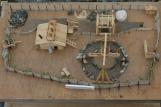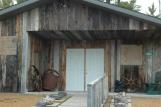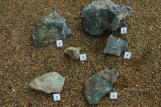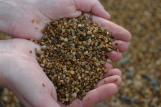2
The Simpson Mine was one of many that were being worked in 1848. In August 1992 the restored Simpson Mine shaft was officially presented to the public with a recreated horse whim, open head frame, and shop displaying artifacts of the original mining days. The Simpson shaft was chosen for restoration over other shafts due to accessibility and cost efficiency. The mine was approximately 100 feet (30m) long and originally 45 feet (15m) deep. For safety reasons, the shaft was filled in to a depth of about 12 feet and a pumping system installed to keep it dry.3
Model of the reconstructed Simpson Mine Shaft.1992
Simpson Mine Shaft, Bruce Mines, Ontario, Canada

5
This is a vein of white quartz, surrounded by black diabase. When searching for copper the early prospectors would have cleared areas of trees and brush looking for this type of vein, which also may have had the green stain of malachite showing.7
Mineral Samples1. Native copper, very close to pure copper. This sample was found on the south shore of Lake Superior.
2. Malachite - The green coloring from the malachite would be absorbed into surrounding wood or bones. Where there was malachite, there was usually copper.
3. Bornite - The small grey fragment in this quartz contains 80% copper.
4. Chalcopyrite - In this area chalcopyrite contains around 35% copper. It has been referred to as fool's gold, which is not technically correct since iron pyrite is fool's gold.
5. Chalcocite - Contains 80% copper.
6. Native copper



